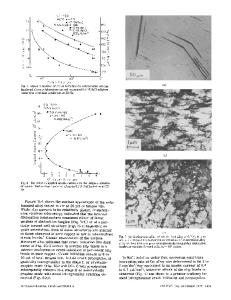Effect of pH value on the corrosion and corrosion fatigue behavior of AM60 magnesium alloy
- PDF / 900,594 Bytes
- 10 Pages / 584.957 x 782.986 pts Page_size
- 84 Downloads / 369 Views
School of Chemical Engineering and Technology, Tianjin University, Tianjin 300072, People’s Republic of China School of Mechanical Engineering, Tianjin University of Technology, Tianjin 300191, People’s Republic of China a) Address all correspondence to these authors. e-mail: [email protected] b) e-mail: [email protected] 2
Received: 28 June 2018; accepted: 12 December 2018
To understand the effect of pH value on the corrosion and corrosion fatigue behavior of AM60 magnesium alloy, electrochemical tests, viz., electrochemical impedance spectroscopy (EIS) and fatigue tests, were carried out in PBS (phosphate buffered saline) solutions of pH 5.2, 7.4, and 9.0. The microstructure was investigated by scanning electron microscopy (SEM). Results are as follows: (i) the corrosion mechanism of AM60 under different pH values was different according to EIS; (ii) the corrosion resistance and corrosion fatigue life reduced in the following order: pH 9.0 . pH 7.4 . pH 5.2; (iii) the crack initiation was associated with hydrogen embrittlement of AM60 on the basis of fractographic analysis.
Introduction Compared to traditional metallic biomaterials (such as stainless steel, Ti alloys, and Co alloys), magnesium and its alloys have many advantages in the case of orthopedic implants, such as low density, low Young’s modulus, and biodegradability [1, 2, 3, 4, 5]. These advantages make it possible to avoid second surgery and eliminate stress shielding effect [6, 7]. However, one of the largest obstacles for clinical application of magnesium implants is their fast degradation. The fast degradation may result in the prefailure of in vivo implants, and the excessive gas bubbles can block the blood flow [8, 9]. Under in vivo environment, the chloride ion concentration of the body fluid is about 150 mmol/L and the corrosion of magnesium is easy to occur. Furthermore, the orthopedic implants will also experience cyclic loading due to walking, running, and jumping [10, 11]. The synergistic effect of corrosion and cyclic loading (i.e., corrosion fatigue) will cause magnesium and its alloys much more susceptible to failure. Accordingly, it is important to research the corrosion fatigue behavior of magnesium and its alloys under the simulated body fluid. There have been a large number of studies dealing with the corrosion behavior of magnesium and its alloys [12, 13, 14]. However, only limited work has addressed the corrosion fatigue behavior of magnesium alloys under simulated body
ª Materials Research Society 2019
fluid [15, 16, 17, 18, 19, 20]. Corrosion fatigue behaviors of WE43, AZ91D, Mg–Ca, Mg–Zn–Ca, and HP-Mg under simulated body fluid were systematically investigated by Zheng et al. [9, 15], who found that the fatigue life decreases due to the stress concentration of corrosion pit and the corrosion rate increases with increasing cyclic loading due to the stress corrosion behavior. Raman et al. [10] studied the corrosion fatigue behavior of AZ91D with different electrochemical conditions under modified simulated body fluid. The results
Data Loading...











